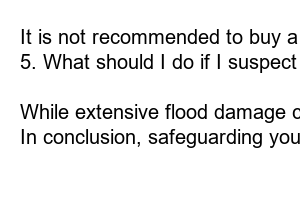침수차 확인하는 방법
Title: How to Check for Flood Damage in a Car: A Comprehensive Guide
Introduction:
Buying a used car can be an exciting and cost-effective option. However, hidden faults such as flood damage can turn this investment into a nightmare. Checking for flood damage is crucial to ensure you’re making a wise purchase. In this blog post, we’ll provide you with a step-by-step guide on how to check for flood damage in a car before making a purchase.
1. Exterior Inspection: Look for Visible Signs
When inspecting a car, pay close attention to the exterior for any noticeable signs of water damage. Check for water lines, mud residue, or even a musty odor. Additionally, look for any indications of recently replaced parts or mismatched paint, which might suggest repairs due to flood damage.
2. Interior Examination: Beware of Telltale Signs
Open the doors and examine the interior thoroughly. Look for dampness, water stains, discolored or faded upholstery, and moldy odors. Check beneath the carpets for moisture, as this area is likely to retain water in the event of a flood.
3. Electrical System Analysis: Test Every Component
Flood damage often affects a car’s electrical system. Test every component, including lights, windows, radio, and air conditioning system, to ensure they work correctly without any glitches or random malfunctions. Water damage may take time to manifest, so be thorough in your tests.
4. Engine Inspection: Seek Professional Assistance
The engine may not reveal visible flood damage, but a professional inspection can help detect any hidden signs of water intrusion. An experienced mechanic can assess the engine, its components, and electrical connections, providing valuable insights into its overall condition.
5. Vehicle History Report: Uncover the Past
Obtain a vehicle history report to reveal crucial details about the car’s past, including whether it has been involved in flooding. While not foolproof, these reports can serve as a starting point to determine if further investigation is necessary.
6. Professional Assistance: Get an Expert Opinion
If you’re unsure about your ability to spot flood damage, consider seeking the help of a professional mechanic or a trusted automobile inspection service. These experts possess the necessary knowledge and experience to evaluate a used car thoroughly.
7. Summing It Up: Protecting Your Investment
Checking for flood damage in a car is a crucial step in purchasing a used vehicle. By thoroughly inspecting the exterior and interior, analyzing the electrical system, getting an engine inspection, reviewing the vehicle history report, and considering professional assistance, you can make an informed decision and protect your investment.
FAQs:
1. How can I check if a car has been in a flood without a history report?
Without a vehicle history report, you can look for visible signs of water damage, including water lines, mud residue, and a musty odor. Additionally, inspect the interior for dampness, water stains, and moldy odors.
2. Can electrical issues in a used car be proof of flood damage?
While electrical issues may not always indicate flood damage, it is one of the common repercussions. Testing the electrical components thoroughly and seeking professional assistance can help determine the root cause.
3. Will a flooded car always have a salvage title?
Not necessarily. A flooded car may or may not have a salvage title as it depends on state regulations and how extensively the car was damaged.
4. Can I still buy a car with flood damage?
It is not recommended to buy a car with flood damage unless you are willing to bear the potential risks and expenses of repairing and maintaining it.
5. What should I do if I suspect the used car I purchased has flood damage?
If you suspect flood damage after purchasing a used car, consult with a trusted mechanic or a vehicle inspection service to assess the extent of the damage and advise you on the next steps.
6. Are all flood-damaged cars are total losses?
While extensive flood damage can lead to a car being deemed a total loss, it depends on the nature and severity of the damage. Some flood-damaged cars can be repaired, but it is important to carefully weigh the costs involved and consider the potential long-term consequences.
In conclusion, safeguarding yourself against buying a flood-damaged car requires a systematic inspection, thorough testing, and seeking expert advice. By following these steps, you can avoid potentially costly mistakes and make a well-informed decision when purchasing a used car.

